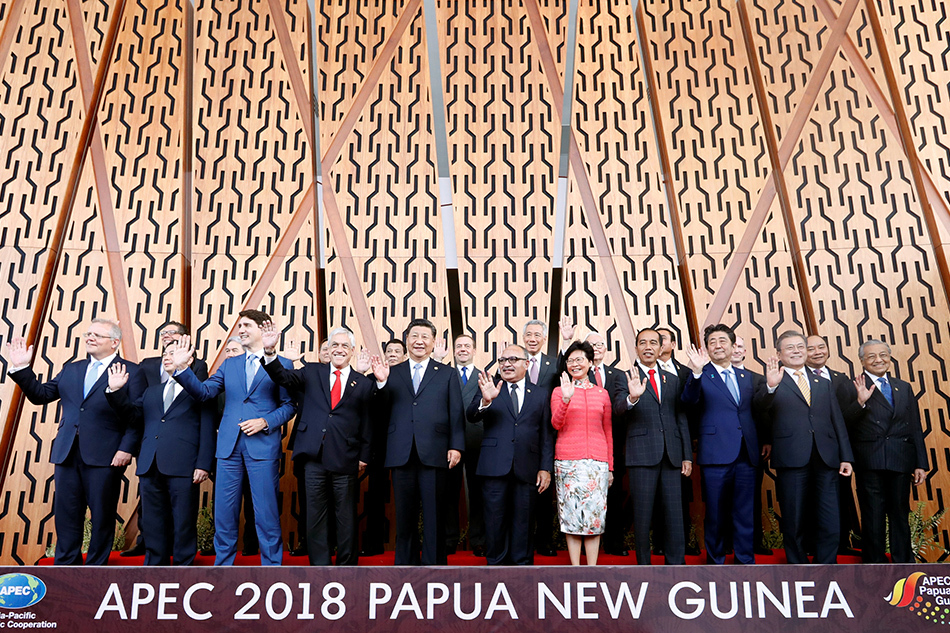[New Economic Non-Order: 4] APEC becomes battleground for US, China
By Jung Min-kyungPublished : Oct. 9, 2019 - 15:21
The Korea Herald is publishing a series of articles to look into the weakening of the global economic framework in light of fading liberalism and the rise of trade protectionism and nationalism. This is the fourth installment. -- Ed.
After last year’s Asia-Pacific Economic Cooperation summit, the headlines announced a first in the forum’s 25-year history: Its 21 members had failed to reach a consensus on a joint communique, one repercussion from the ongoing US-China trade war.
In recent years, the escalating tension between the world’s two largest economies has shattered the mood of liberalism that was the foundation of APEC.
After last year’s Asia-Pacific Economic Cooperation summit, the headlines announced a first in the forum’s 25-year history: Its 21 members had failed to reach a consensus on a joint communique, one repercussion from the ongoing US-China trade war.
In recent years, the escalating tension between the world’s two largest economies has shattered the mood of liberalism that was the foundation of APEC.

Since US President Donald Trump took office in 2017, his “America First” policy based on nationalism and trade protectionism has fed the narrative that organizations and forums that serve as mediators among economies, including the World Trade Organization and APEC, are “irrelevant.”
APEC was founded in 1989 with the goal of reinforcing trade ties around the Pacific Ocean. Australian former Prime Minister Bob Hawke spearheaded the idea during a speech in Seoul in January 1989. The founding members were Australia, Brunei, Canada, Indonesia, Japan, South Korea, Malaysia, New Zealand, the Philippines, Singapore, Thailand and the United States.
China, Hong Kong and Taiwan joined in 1991, followed by Mexico and Papua New Guinea in 1993, Chile in 1994, and Peru, Russia and Vietnam in 1998.
It operated at a ministerial level until the early 1990s, a peaceful era for supporters of the liberal international economic order. In 1993, then-US President Bill Clinton launched the annual leaders meetings.
Despite ups and downs, the meetings managed to produce a joint communique or statement every year until last year, when the US-China trade war soured the forum’s spirit.
The 2018 APEC summit in Papua New Guinea was a battleground between Washington and Beijing, with both sides delivering blunt criticisms of each other’s policies as the other member nations either stood by frowning or scrambled to pick sides.
Trump decided to skip that meeting, so US Vice President Mike Pence stood in his place to lambaste China’s Belt and Road Initiative, a global development strategy that aims to connect infrastructure in 152 nations around the world through investment. Calling the initiative a “constricting belt” and a “one-way road,” Pence urged the other nations not to accept foreign debt that might compromise their sovereignty.
Chinese President Xi Jinping, meanwhile, defended the initiative and stressed that “nobody should stop people in developing countries from pursuing a better life.”
Despite the feud that disrupted the meeting last year, some analysts and experts remain hopeful that this year’s APEC summit, to be held in November in Chile, will provide a chance for Washington and Beijing to discuss their issues and come up with a temporary solution to alleviate the tension.
“There is still strong belief that the US and China will reach a small deal or a truce between the Nov. 16-17 APEC summit and Dec. 15, when the majority of Beijing’s tariffs imposed on US imports are to take effect,” Hana Investment & Securities analyst Kim Yong-gu said.
If Trump decides to attend this year, it will be an opportunity for Xi to come face to face with his US counterpart again after the G20 meeting in Osaka in July. At that meeting, the US and China formally agreed to restart their stalled trade talks. Trump and Xi said they would refrain from imposing new tariffs, and Trump pledged to ease restrictions on Chinese telecom giant Huawei.
However, the results of the July meeting have yet to bear fruit, with both sides continuing to impose tariffs and resist compromise.
Since September, China and the US have imposed fresh tariffs on each other’s imports as Washington began collecting 15 percent tariffs on a long list of Chinese products, worth more than $125 billion altogether. China, in turn, began collecting additional tariffs on certain items on a list of US imports worth $75 billion. Beijing is set to impose additional tariffs on the rest of the products on the list from Dec. 15.
Kim added that Trump is likely to tone down his trade rhetoric toward China as the 2020 US presidential election approaches.
But at the same time, others believe China is most likely hoping for an end to the Trump administration in 2020 and intends to wait it out, viewing the upcoming APEC meeting as a mere formality -- that is, if Trump and Xi attend at all.
According to a report released by Goldman Sachs in August, the US and China will not be able to resolve their ongoing trade dispute before next year’s election. The report came a week after Trump said he would impose 10 percent tariffs on $300 billion worth of Chinese goods.
“News since President Trump’s tariff announcement last Thursday indicates that US and Chinese policymakers are taking a harder line, and we no longer expect a trade deal before the 2020 election,” the report said.
By Jung Min-kyung (mkjung@heraldcorp.com)







![[KH Explains] How should Korea adjust its trade defenses against Chinese EVs?](http://res.heraldm.com/phpwas/restmb_idxmake.php?idx=644&simg=/content/image/2024/04/15/20240415050562_0.jpg&u=20240415144419)












![[Today’s K-pop] Stray Kids to return soon: report](http://res.heraldm.com/phpwas/restmb_idxmake.php?idx=642&simg=/content/image/2024/04/16/20240416050713_0.jpg&u=)